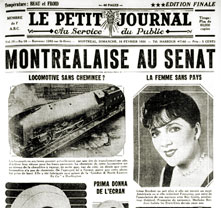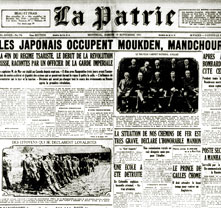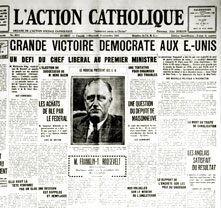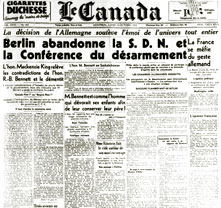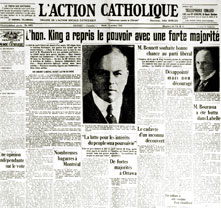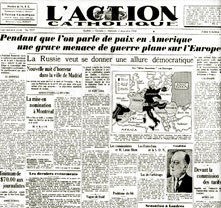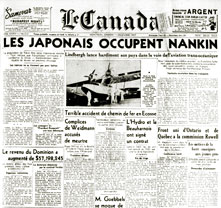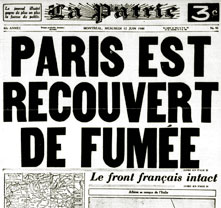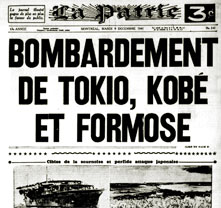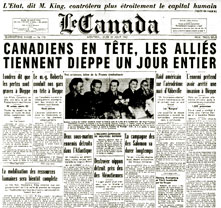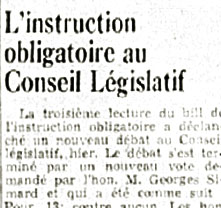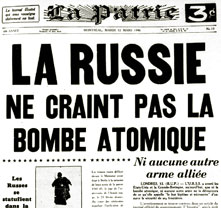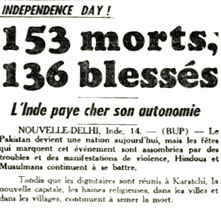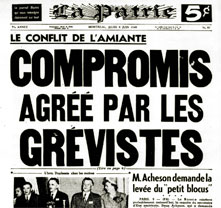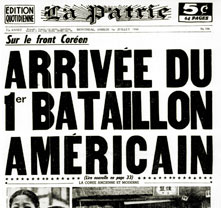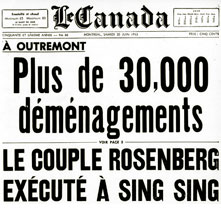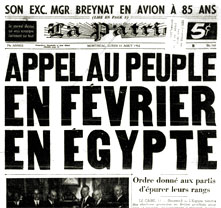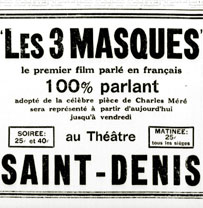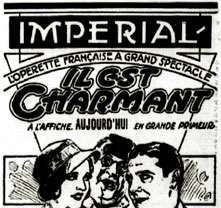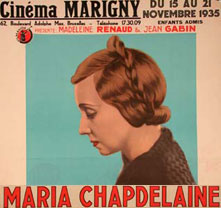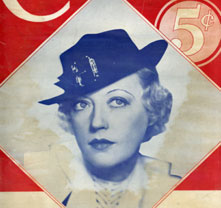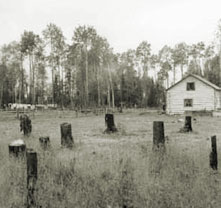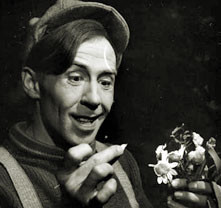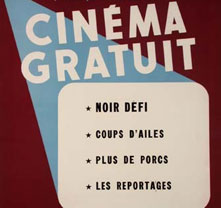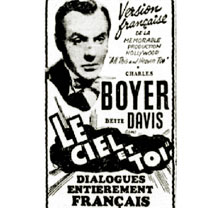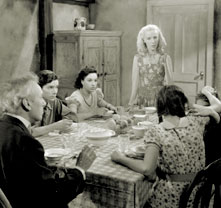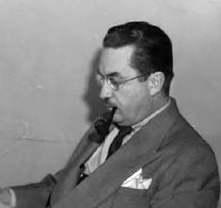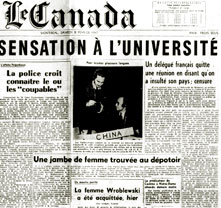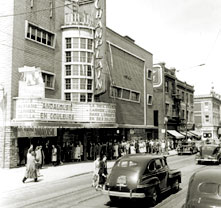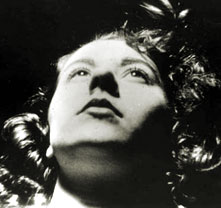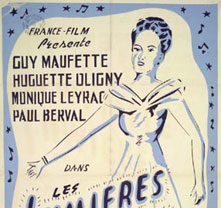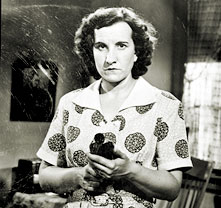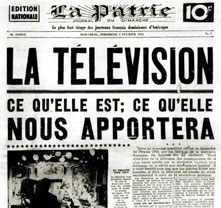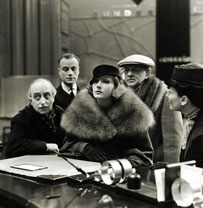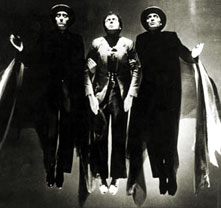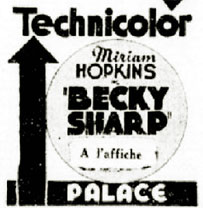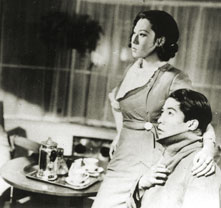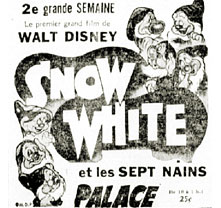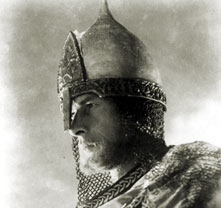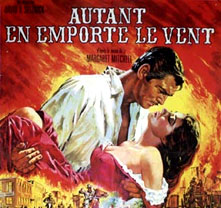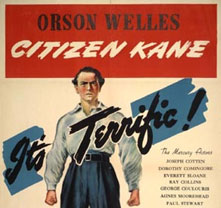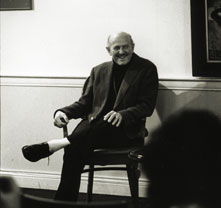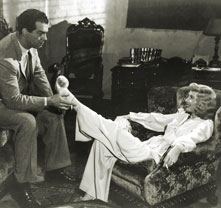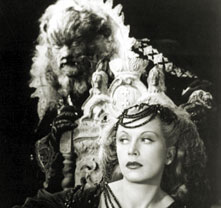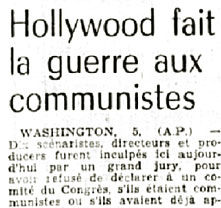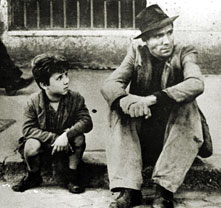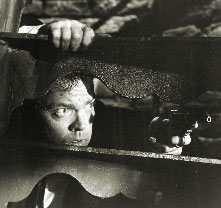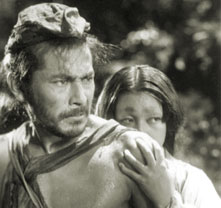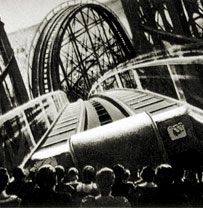1930 - A Woman in the Senate
15 February: Cairine Wilson becomes the first woman named to the Canadian Senate. That same day, Quebec’s Commission d’enquête sur les droits civiques des femmes files its report on the status of women.
Also in 1930:
A boycott against British goods and the civil disobedience movement begin in India.
The Canadian government decides to suspend immigration from Europe because of the economic crisis.
Le Petit Journal, Sunday 16 February 1930, p. 1.
Source : Bibliothèque et Archives nationales du Québec
1931 - The Invasion of Manchuria
In September, Japan invades Manchuria, which a few months later becomes the country Manchukuo.
Also in 1931:
Canada’s independence is officially recognised by the Statute of Westminster.
La Patrie, Saturday 19 September 1931, p. 1.
Source : Bibliothèque et Archives nationales du Québec
1932 - Franklin D. Roosevelt
The Democrat Franklin D. Roosevelt is elected president of the United States. He launches the New Deal, a series of programs whose goal is to extricate the country from the Depression.
Also in 1932:
The Gordon Plan sends unemployed from Quebec’s cities to live in Abitibi.
Stalin’s policies lead to famine in the Soviet Union.
L’Action catholique, Wednesday 9 November 1932, p. 1
Source : Bibliothèque et Archives nationales du Québec.
1933 - The Nazis Take Power
Adolf Hitler, leader of the National Socialist Party, takes power in Germany and institutes a dictatorship. Germany withdraws from the League of Nations in October.
Le Canada, Monday 16 October 1933, p. 1.
Source : Bibliothèque et Archives nationales du Québec
1934 - Bonnie and Clyde
23 May: the famous bandits Bonnie Parker and Clyde Barrow are ambushed and killed by police in Louisiana.
Also in 1934:
Persia becomes Iran.
Le Canada, Thursday 24 May 1934, p. 1.
Source : Bibliothèque et Archives nationales du Québec
1935 - Mackenzie King is Re-elected
William Lyon Mackenzie King returns to power after five years in opposition. He will lead Canada during the Second World War.
Also in 1935:
Italy declares war on Ethiopia.
L’Action catholique, Tuesday 15 October, 1935, p. 1.
Source : Bibliothèque et Archives nationales du Québec
1936 - The Spanish Civil War
In Spain, a military insurrection opposed to the Republic, led by General Franco, is transformed into a civil war. It is believed that between 300,000 and 400,000 people will die in the conflict between 1936 and the defeat of the Republican government in the spring of 1939.
Also in 1936:
In Quebec, Maurice Duplessis’ Union Nationale party is elected for the first time.
In England, King Edward VIII abdicates in order to marry the divorcée Wallis Simpson.
In France, the Popular Front is elected.
Le Canada, Wednesday 2 December 1936, p. 1.
Source : Bibliothèque et Archives nationales du Québec
1937 - The Sino-Japanese War
During the summer, Japan invades the eastern part of China. In December, the city of Nanking, under the control of Chang Kai-shek, is the site of atrocities committed by the Japanese forces.
Le Canada, Saturday 11 December 1937, p. 1.
Source : Bibliothèque et Archives nationales du Québec
1938 - Germany Annexes Austria and “Sudetenland”
After the occupation and annexation of Austria, Germany lays claim to and obtains a part of Czechoslovakia under the Munich Agreement.
Also in 1938:
The Kristallnacht or Night of Broken Glass signals a new wave of anti-Semitic violence in Nazi Germany.
Le Canada, Friday 30 September 1938, p. 1.
Source : Bibliothèque et Archives nationales du Québec
1939 - Second World War
On 1 September, German troops invade Poland. France, Great Britain and Canada respond by declaring war on Nazi Germany.
Also in 1939:
Adélard Godbout’s Liberals take power in Quebec.
La Patrie, Friday 1 September 1939, p. 1.
Source : Bibliothèque et Archives nationales du Québec
1940 - Occupied France
10 May: the Germans’ westward campaign begins. In June, half of France is occupied. In August, the German air force begins bombing Great Britain. The Battle of Britain will be lost by the Nazis.
Also in 1940:
In Quebec, the Godbout government grants women the right to vote.
La Patrie, Wednesday 12 June 1940, p. 1.
Source : Bibliothèque et Archives nationales du Québec
1941 - The Attack on Pearl Harbor
7 December: the surprise Japanese attack on the Pearl Harbor naval base in the Pacific prompts the United States to enter the war. The British colony Hong Kong falls on 25 December.
Also in 1941:
The German invasion of the Soviet Union puts an end to the German-Soviet Non-Aggression Pact.
La Patrie, Tuesday 9 December 1941, p. 1.
Source : Bibliothèque et Archives nationales du Québec
1942 - Disaster at Dieppe
19 August: Canadian troops land on the shores of Dieppe. They are quickly forced to retreat, with the loss of 2,000 men.
Also in 1942:
The Canadian government holds a referendum on the question of conscription.
Le Canada, Thursday 20 August 1942, p. 1.
Source : Bibliothèque et Archives nationales du Québec
1943 - Obligatory Education
26 May: the Quebec government makes education free and obligatory.
Also in 1943:
The Allies land in Italy.
L’Action catholique, Thursday 27 May, 1943, p. 3.
Source : Bibliothèque et Archives nationales du Québec.
1944 - Duplessis Re-elected
Maurice Duplessis is re-elected premier of Quebec after four years in opposition. He will remain in power until his death in 1959.
Also in 1944:
6 June: the Allies land in Normandy.
11 October: in Canada, the seventh Victory Bonds campaign is launched.
Caricature by Robert LaPalme, Le Canada, Wednesday 9 August 1944, p. 4.
Source : Bibliothèque et Archives nationales du Québec
1945 - An Armistice and Two Atomic Bombs
8 May: hostilities in Europe cease with the capitulation of Nazi Germany. Japan does not surrender until 2 September, after two atomic bombs are dropped on Hiroshima and Nagasaki.
Also in 1945:
The United Nations is born.
La Patrie, Tuesday 7 May 1945, p. 1.
Source : Bibliothèque et Archives nationales du Québec
1946 - The Cold War
The United States undertakes nuclear tests in the Pacific in an atmosphere of growing tension between the Soviet Union and Western powers.
Also in 1946:
The Indochina War begins.
La Patrie, Tuesday 12 March 1946, p. 1.
Source : Bibliothèque et Archives nationales du Québec
1947 - India is Partitioned
14 August: the partition of India gives birth to Pakistan and sets off immediate conflicts between Hindus and Muslims.
La Patrie, Thursday 14 August 1947, p. 3.
Source : Bibliothèque et Archives nationales du Québec
1948 - The State of Israel is Founded
The proclamation of the state of Israel sets off the first Israeli-Arab war, which ends in June 1949.
Also in 1948:
The Universal Declaration of Human Rights is adopted by the General Assembly of the United Nations.
Harry Truman, president of the United States, signs the Marshall Plan, whose goal is the reconstruction of Europe.
In Quebec, a group of intellectuals and artists denounce the reigning conservatism with the “Refus global” manifesto.
Le Canada, Thursday 11 December 1947, p. 1.
Source : Bibliothèque et Archives nationales du Québec
1949 - The Asbestos Strike
5,000 miners employed by American companies in Quebec launch the Asbestos Strike. A vast movement is organised to counter the Duplessis government’s anti-union policies.
Also in 1949:
Mao Zedong proclaims the People’s Republic of China.
Founding of the North Atlantic Treaty Organisation (NATO), a military alliance between twelve Western countries, including Canada.
La Patrie, Thursday 9 June 1949, p. 1.
Source : Bibliothèque et Archives nationales du Québec
1950 - The Korean War
Following the intervention of the great powers, the war between South Korea and North Korea, supported by China and the Soviet Union, becomes a confrontation between the West and the communist world.
La Patrie, Saturday 1 July 1950, p. 1.
Source : Bibliothèque et Archives nationales du Québec
1951 - The Rosenberg Affair
In the United States, the couple Ethel and Julius Rosenberg are accused of spying for the Soviet Union and sentenced to death.
Le Canada, Saturday 20 June, 1953, p. 1.
Source : Bibliothèque et Archives nationales du Québec
1930 - The Beginnings of French Talking Cinema in Quebec
31 May: Montreal’s Théâtre St-Denis premieres Les trois masques, the first French talking film.
Also in 1930:
28 January: the Taschereau government adopts a law subjecting advertisements for films in newspapers to censorship.
La Patrie, Saturday 31 May 1930, p. 20.
Source : Bibliothèque et Archives nationales du Québec
1931 - White Commission
30 April: Commissioner White submits the report Investigation Into an Alleged Combine in the Motion Picture Industry in Canada, the conclusion of his inquiry into the activities of Famous Players Canadian Corp.
1932 - French Cinema at Famous Players
26 March: Montreal’s Imperial cinema presents Il est charmant, an operetta shot in Paramount’s French studios. Several of Paramount’s other French productions are screened at the Imperial in the following months.
La Patrie, Saturday 26 March 1932, p. 17.
Source : Bibliothèque et Archives nationales du Québec
1934 - Maria Chapdelaine
Julien Duvivier arrives in Quebec to shoot Maria Chapdelaine. Adapted from the popular novel by Louis Hémon, the film stars Jean Gabin and Madeleine Renaud.
Also in 1934:
1 October: the two largest distributors of French films in Quebec, Franco-Canada Films and France-Film, merge and take the latter’s name. J.A. DeSève is the person really in charge of the new company.
Poster for the film Maria Chapdelaine (Julien Duvivier, 1934).
Source : Cinémathèque québécoise, 1988.2299.AF
1935 - Le Courrier du cinéma
December: France-Film launches its promotional journal Le Courrier du cinéma.
Also in 1935:
Broadcast of the first radio serial, Le curé de village, written by Robert Choquette.
The first issue of Le Courrier du cinéma, December 1935.
Source : Cinémathèque québécoise
1936 - Vigilanti cura
June: the publication of the encyclical Vigilanti cura marks a turning point in the Church’s relationship with the cinema. In it, Pope Pius XI states that the cinema, although it has often been put to pernicious use, is not inherently immoral. He invites Catholics to make use of this powerful means of communication.
Also in 1936:
Associated Screen News, producer of Canadian Cameos, builds the largest Canadian sound studio in Montreal.
The Canadian Broadcasting Corporation (CBC) replaces the Canadian Radio Broadcasting Commission.
L’Action catholique, Monday 1 May 1939, p. 15.
Source : Bibliothèque et Archives nationales du Québec
1937 - En pays neufs
Abbot Maurice Proulx depicts the settling of the Abitibi region in the feature-length documentary En pays neufs, made between 1934 and 1937.
Film Still.
Source : Cinémathèque québécoise, 1995.1091.PH
1938 - Les Fridolinades
Gratien Gélinas presents the first edition of his stage review Les Fridolinades. Gélinas will make the film La dame aux camélias, la vraie, a parody of the novel by Alexandre Dumas fils, for the 1943 edition of Les Fridolinades.
Fridolin (Gratien Gélinas)
Source : Cinémathèque québécoise, 1995.1287.PH
1939 - National Film Board of Canada
In Ottawa, John Grierson founds the National Film Board of Canada (NFB), whose mandate is to “make and distribute films designed to help Canadians in all parts of Canada to understand the ways of living and the problems of Canadians in other parts.” The NFB will become an important information and propaganda tool during the Second World War.
Also in 1939:
Crawley Films, founded in Ottawa by Judith and Budge Crawley, quickly becomes the largest Canadian producer of educational, industrial and commissioned films.
Program of a screening organised by the NFB during the Second World War.
Source : Cinémathèque québécoise, 2006.0181.AF
1941 - The Service de Ciné-photographie is created
The Godbout government centralises the production and distribution throughout Quebec of films about health, education, agriculture and tourism by creating the Service de Ciné-photographie.
Also in 1941:
The NFB hires its first French Canadian filmmakers: Vincent Paquette, Jean Palardy and Pierre Petel.
The NFB’s French-language newsreel service Reportages debuts in September.
Herménégilde Lavoie, filmmaker with the Service de Ciné-photographie.
Source : Cinémathèque québécoise, 2000.0252.PH
1943 - Dubbing is a Success
23 November: success of Le ciel et toi, the French-language version of All This and Heaven Too screened at the Capitol in Quebec City and the Orpheum in Montreal in April 1944. American studios begin to dub a large number of their films.
Also in 1943:
The missionary priest Jean-Marie Poitevin promotes the activities of the Society of Apostolic Life in the feature film À la croisée des chemins. Images shot by Poitevin in Asia between 1933 and 1939, along with footage of Montreal’s three-hundredth anniversary celebrations, are embedded in a fictional story about the dilemma of a young man who has “heard God’s call”.
La Patrie, Saturday 8 April 1944, p. 38.
Source : Bibliothèque et Archives nationales du Québec
1945 - Le père Chopin
20 April: Montreal’s Théâtre St-Denis presents the premiere of Le père Chopin.
A Dupont family meal in Le père Chopin (Fedor Ozep, 1945).
Source : Cinémathèque québécoise, 1995.2188.PH.03
1946 - Québec Productions is founded
Paul L’Anglais and René Germain found Québec Productions, specialising in the production of films in French and English versions. Studios are built in Saint-Hyacinthe.
Also in 1946:
Renaissance Film Distribution and Fiat Films of Paris join efforts to produce Catholic films.
Paul L’Anglais at work.
Source : Cinémathèque québécoise, 1998.2112.PH.3934
1947 - Les enfants du paradis is placed on the index
7 February: the condemnation of Marcel Carné and Jacques Prévert’s masterpiece Les enfants du paradis (The Children of Paradise) by the Board of Censors sets off a diplomatic quarrel between the Duplessis government and France.
Also in 1947:
Duplessis denounces the supposedly centralising and communist tendencies of films produced by the National Film Board of Canada. He extends the Board of Censor’s jurisdiction to 16mm films in order to control the distribution of NFB films.
In exchange for the Canadian government’s abandonment of steps to establish import quotas, the American majors ratify the Canadian Co-operation Project, committing them to distribute Canadian documentaries in the United States and to shoot a certain number of films in Canada.
Le Canada, Saturday 8 February 1947, p. 1.
Source : Bibliothèque et Archives nationales du Québec
1948 - Odeon
Odeon Theatres of Canada builds three modern cinemas in Montreal, including the Champlain, which for many years will be the company’s most prestigious cinema in Quebec, showing mostly American films dubbed into French. The Odeon chain is controlled by British interests.
Also in 1948:
Production of the film Un homme et son péché, adapted from the radio serial by Claude-Henri Grignon.
Source : Cinémathèque québécoise, 1999.0081.PH.02
1949 - Mouvement perpétuel
Nineteen-year-old Claude Jutra makes the experimental short film Mouvement perpétuel.
Also in 1949:
The group Young Catholic Students establishes the first student film societies.
Film still.
Source : Cinémathèque québécoise, 1995.1920.PH.02
1950 - Les lumières de ma ville
Excelsior Film succeeds Productions Renaissance and produces the musical comedy Les lumières de ma ville. Both companies will declare bankruptcy before the end of 1951.
Also in 1950:
Otto Preminger shoots a remake of Henri-Georges Clouzot’s film Le Corbeau (The Raven), called The Thirteenth Letter, in the studios of Québec Productions.
Poster for the film Les lumières de ma ville (Jean-Yves Bigras, 1950).
Source : Cinémathèque québécoise, 1988.1400.AF
1951 - La petite Aurore, l’enfant martyre
The film La petite Aurore, l’enfant martyre, adapted from Émile Asselin’s famous play, is shot in the summer. It becomes one of the greatest popular successes in the history of Quebec cinema.
Also in 1951:
Publication of the report of the Royal Commission on National Development in the Arts, Letters and Sciences, better known as the Massey Commission. The report recommends in particular that funding for the National Film Board be maintained and that the development of Canadian television be entrusted to the Canadian Broadcasting Corporation.
Production still.
Source : Cinémathèque québécoise, 1998.2058.PH
1952 - Television Arrives
6 September: the Canadian Broadcasting Corporation launches its television programming.
Also in 1952:
20 August: Alfred Hitchcock begins shooting I Confess in Quebec City.
Gratien Gélinas adapts his play Tit-coq to film.
La Patrie, Sunday 3 February 1952, p. 1.
Source : Bibliothèque et Archives nationales du Québec
1930 - The Blue Angel
Josef von Sternberg makes the first German talking film, The Blue Angel (Der blaue Engel), starring Marlene Dietrich.
Production still.
Source : Cinémathèque québécoise, 1994.1084.PH.08
1931 - Marius
Alexander Korda makes Marius, the first film in Marcel Pagnol’s Marseilles trilogy. Fanny and César follow in 1932 and 1936.
Also in 1931:
Sound recording and playback methods in cinema are standardised by international agreement.
Production still.
Source : Yves Lever
1932 - Grand Hotel
Grand Hotel, starring Greta Garbo, John Barrymore and Joan Crawford, wins the Oscar for best film.
Production still.
Source : Cinémathèque québécoise, 1994.3572.PH.22
1933 - Fritz Lang Flees Nazi Germany
Following a brief stay in Paris, the director of Metropolis and M, fleeing Nazi Germany, settles in the United States, where he continues his career.
Also in 1933:
London: The British Film Institute is founded.
Liliom (1934), production still.
Source : Cinémathèque québécoise, 1994.5137.PH.03
1934 - The Hays Code
The major U.S. production companies agree to subject their films to the Hays Code governing the depiction, in particular, of sex and violence on the screen. The Code will remain in effect until the 1960s.
Also in 1934:
Leni Riefenstahl shoots Triumph of the Will (Triumph des Willens) at a Nazi party rally in Nuremberg.
Jean Vigo’s L’Atalante is released in a version re-edited by Gaumont.
Betty Boop before the Hays Code.
Source : Cinémathèque québécoise, 1993.0270.AR.02
1935 - Becky Sharp
Rouben Mamoulian becomes the first film director to use three-colour Technicolor for a feature film.
Also in 1935:
New York’s Museum of Modern Art opens a film library.
La Patrie, Saturday 27 July 1935, p. 42.
Source : Bibliothèque et Archives nationales du Québec.
1936 - Osaka Elegy
The Japanese filmmaker Kenji Mizoguchi explores the theme of the status of women in Japan in his early masterpiece Osaka Elegy (Naniwa hika).
Also in 1936:
Charles Chaplin’s Modern Times is released.
Production still.
Source : Cinémathèque québécoise, 1994.6194.PH
1937 - Snow White and the Seven Dwarfs
Walt Disney scores a remarkable success with Snow White and the Seven Dwarfs, the first talking, feature-length animated film in colour.
Also in 1937:
Rome: fifteen months after the first stone is laid by Mussolini, the Cinecittà studios open.
As signs of the approaching Second World War become apparent, Jean Renoir completes La Grande illusion.
Le Canada, Saturday 5 March 1938, p.6.
Source : Bibliothèque et Archives nationales du Québec
1938 - Alexandre Nevski
With Alexander Nevsky, Eisenstein issues a warning to those who would attempt to invade Russia.
Also in 1938:
Marcel Carné and Jacques Prévert make Quai des brumes, an emblematic work of French poetic realism.
Paris: the International Federation of Film Archives is founded.
Production still.
Source : Cinémathèque québécoise, 1994.0179.PH.01
1939 - Gone with the Wind
Producer David O. Selznick triumphs with Gone With the Wind, a superproduction in which the Hollywood style is taken to its paroxysm.
Poster(French version).
Source : Cinémathèque québécoise, 1995.1036.AF
1940 - The Great Dictator
With the United States still officially neutral, Charles Chaplin takes sides against tyranny in The Great Dictator.
Also in 1940:
Warner Bros. animators create Bugs Bunny.
In France, the Vichy regime bans numerous films, including La Grande illusion.
Source : Cinémathèque québécoise, 1994.3604.PH.09
1941 - Citizen Kane
For his first film, Citizen Kane, Orson Welles draws on the life of newspaper baron William Randolph Hearst.
Poster.
Source : Cinémathèque québécoise, 1988.2428.AF
1942 - The 49th Parallel
In the suspense film The 49th Parallel, the British filmmaker Michael Powell depicts a Canada united against its Nazi enemy.
Michael Powell.
Source : Cinémathèque québécoise
1943 - Le corbeau
Henri-Georges Clouzot’s Le corbeau (The Raven) opens in Occupied France. Later, Clouzot will be reproached for the film’s sombre portrait of France and the French people.
Also in 1943:
The Italian filmmaker Luchino Visconti’s Ossessione becomes one of the first films of the neo-realist movement.
Carl Dreyer makes Day of Wrath (Vredens dag) under German occupation in Denmark.
Production still.
Source : Cinémathèque québécoise, 1994.1926.V02.PH
1944 - Double Indemnity
Billy Wilder makes one of the greatest film noir movies with Double Indemnity, adapted by Raymond Chandler from a novel by James M. Cain.
Production still.
Source : Cinémathèque québécoise, 1994.2444.PH
1945 - Rome, Open City
In Rome, Open City (Roma, città aperta), Roberto Rossellini recreates the final months of the war in Italy and propels Italian neo-realism to the forefront of world cinema.
Also in 1945:
Film production is nationalised in several countries under Soviet influence, including Czechoslovakia, Yugoslavia and Poland. Hungary, Romania and Bulgaria follow suit in 1946.
Le Canada, Monday 28 July 1947, p. 5.
Source : Bibliothèque et Archives nationales du Québec
1946 - La belle et la bête
Jean Cocteau triumphs with his adaptation of La belle et la bête (The Beauty and the Beast), an eighteenth-century tale previously adapted to film many times.
Autres événements en 1946:
The Centre national de la Cinématographie is created in France.
Children of the Earth, by Khwaja Ahmad Abbas, becomes one of the first Indian films to be widely released abroad.
Production still.
Source : Cinémathèque québécoise, 1994.0886.V01.PH
1947 - The “Hollywood Ten”
In Hollywood, ten members of the film industry are held in contempt for refusing to answer questions from the House Un-American Activities Committee.
Also in 1947:
Founding of the Actors Studio in New York.
Le Canada, Saturday 6 December, 1947, p. 1.
Source : Bibliothèque et Archives nationales du Québec
1948 - Bicycle Thieves
After examining the horrors of the war, Italian neo-realism turns to everyday tragedies with Vittorio De Sica’s Bicycle Thieves (Ladri di biciclette).
Production still.
Source : Cinémathèque québécoise, 1994.4910.PH.02
1949 - The Third Man
The British filmmaker Carol Reed addresses post-war tensions in The Third Man, set in still-occupied Vienna.
Production still.
Source : Cinémathèque québécoise, 1994.8944.PH
1950 - Rashomon
Akira Kurosawa’s film Rashomon is released in Japan. It will go on to win the Golden Lion prize at the Venice film festival and play an important role in obtaining international recognition for Japanese cinema.
Also in 1950:
Kodak ceases production of 35mm nitrate film and launches Eastmancolor film stock.
Production still.
Source : Cinémathèque québécoise, 1994.7383.PH.02
1951 - Les Cahiers du cinéma
April: first issue of Les Cahiers du cinéma. This new film magazine, edited by André Bazin, soon becomes known for its promotion of the “politique des auteurs” or authorship approach to film criticism.
Cover page, April 1951.
Source : Cinémathèque québécoise
1952 - Cinerama
A panoramic system using three synchronised cameras and projectors, Cinerama is launched in a handful of prestigious cinemas. In Montreal, the Imperial cinema will screen Cinerama films until 1963.
Also in 1952:
Bernard Chardère founds the film magazine Positif in Lyon.
Postcard.
Source : Bibliothèque et Archives nationales du Québec
